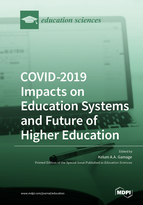COVID-2019 Impacts on Education Systems and Future of Higher Education
A special issue of Education Sciences (ISSN 2227-7102). This special issue belongs to the section "Higher Education".
Deadline for manuscript submissions: closed (31 December 2021) | Viewed by 315988
Special Issue Editor
Interests: educational development and innovation; engineering education; quality assurance and enhancement in engineering programmes; radiation detection and instrumentation
Special Issues, Collections and Topics in MDPI journals
Special Issue Information
Dear Colleagues,
The rapid outbreak of the COVID-19 has presented unprecedented challenges on education systems. Closing schools and universities and cancelling all face-to-face activities have become a COVID-19 inevitable reality in most parts of the world. To be business-as-usual, many higher education providers are taking steps toward digital transformation and implementing a range of remote teaching, learning and assessment approaches. However, many practical matters are yet to be solved.
This Special Issue will provide timely research on COVID-19 impacts on education systems and will cover original articles and review articles. It seeks to bring together scholars, educators, policymakers and practitioners to collectively and critically identify, investigate and share best practices that lead to rethinking and reframing the way we deliver education in future.
Dr. Kelum Gamage
Guest Editor
Manuscript Submission Information
Manuscripts should be submitted online at www.mdpi.com by registering and logging in to this website. Once you are registered, click here to go to the submission form. Manuscripts can be submitted until the deadline. All submissions that pass pre-check are peer-reviewed. Accepted papers will be published continuously in the journal (as soon as accepted) and will be listed together on the special issue website. Research articles, review articles as well as short communications are invited. For planned papers, a title and short abstract (about 100 words) can be sent to the Editorial Office for announcement on this website.
Submitted manuscripts should not have been published previously, nor be under consideration for publication elsewhere (except conference proceedings papers). All manuscripts are thoroughly refereed through a double-blind peer-review process. A guide for authors and other relevant information for submission of manuscripts is available on the Instructions for Authors page. Education Sciences is an international peer-reviewed open access monthly journal published by MDPI.
Please visit the Instructions for Authors page before submitting a manuscript. The Article Processing Charge (APC) for publication in this open access journal is 1800 CHF (Swiss Francs). Submitted papers should be well formatted and use good English. Authors may use MDPI's English editing service prior to publication or during author revisions.
Keywords
- Remote teaching
- Delivery of laboratory and workshop
- Online assessments
- Project supervision
- Student staff partnership
- Student engagement
- Student experience
- Health and wellbeing
- Student placements
- Academic integrity
- Academic standards
- Graduate attributes
- Quality assurance
- Accreditation
- Technological challenges
- Student recruitment
- Financial impact on education providers






